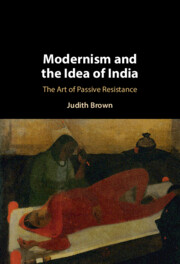Book contents
- Modernism and the Idea of India
- Modernism and the Idea of India
- Copyright page
- Dedication
- Contents
- Figures
- Acknowledgments
- Introduction
- Chapter 1 Tagore’s Emancipated Spectator
- Chapter 2 Questions for R. K. Narayan
- Chapter 3 Amrita Sher-Gil’s Passive Figures
- Chapter 4 Languishing in Ahmed Ali’s Delhi
- Chapter 5 Love and Castration in G. V. Desani
- Chapter 6 Virginia Woolf’s Passive Revolution
- Chapter 7 Le Corbusier’s Impassive Partition Monument
- Works Cited
- Index
Introduction
Published online by Cambridge University Press: 02 January 2025
- Modernism and the Idea of India
- Modernism and the Idea of India
- Copyright page
- Dedication
- Contents
- Figures
- Acknowledgments
- Introduction
- Chapter 1 Tagore’s Emancipated Spectator
- Chapter 2 Questions for R. K. Narayan
- Chapter 3 Amrita Sher-Gil’s Passive Figures
- Chapter 4 Languishing in Ahmed Ali’s Delhi
- Chapter 5 Love and Castration in G. V. Desani
- Chapter 6 Virginia Woolf’s Passive Revolution
- Chapter 7 Le Corbusier’s Impassive Partition Monument
- Works Cited
- Index
Summary
My introduction offers an overview of the rise and fall of Gandhian passive resistance and places it in the context of a burgeoning arts movement both in India and concerned with India. It sketches the arc of the book, from Gandhi’s 1909 pronouncement of passive resistance to the play Tagore would soon write that takes up passivity as a form of unexpected resistance, to the role of the English language in Indian arts, and ends with the modernist memorial commissioned to commemorate the victims of India’s Partition. The introduction’s main work is to define its central concept, map its complications, and locate its role within a global arts movement.
- Type
- Chapter
- Information
- Modernism and the Idea of IndiaThe Art of Passive Resistance, pp. 1 - 21Publisher: Cambridge University PressPrint publication year: 2025

